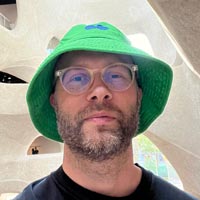A simulation of evolutions
 By Robin Dowling · 9 months ago
By Robin Dowling · 9 months ago
I'm building an evolution simulation where observers can watch as species evolve, thrive, and establish themselves in different regions of their world, only to eventually be displaced by other emerging species.
Species
The simulation models the process of evolution through emergent behavior and randomness. There are no predefined organisms, species, or events. Instead, all life forms are generated based on randomly assigned genetics, and evolution unfolds through the cumulative effects of interaction and adaptation.
Organisms in the simulation are not technically categorized as plants or animals internally. Their genetics determine their role: some remain stationary, effectively resembling plants, while others move and interact with others, resembling animals. Regardless of their behavior, all organisms share the same core objectives: to survive and reproduce.
Species are not static or predefined, but instead form dynamically. Organisms with similar genetics are grouped into species through a process that reduces and transforms genetic data into clusters. Over time, mutations and genetic drift ensure that species composition evolves continually.
Energy
Energy is central to survival. Organisms lose energy over time and must replenish it by consuming other organisms or environmental elements.
Reproducion
Organisms reproduce with suitable mates, and after pregnancy completes, the genetic material of the two mating organisms are combined into an average of both, with mutations introducing variation in their offspring. The success of reproduction depends on both environmental conditions and the ability of organisms to survive long enough to reproduce.
Conflict
Conflict naturally arises as organisms compete for limited resources, access to suitable habitats, and opportunities to reproduce. These conflicts may result in threats, or direct confrontations, sometimes leading to the death of one or more organisms.
Diseases
Diseases add an additional layer of complexity. Like organisms, diseases have genetic profiles and spread based on compatibility with host genetics. Transmission occurs through proximity or specific interactions, and the severity of their effects depends on the genetic match between the disease and the host as well as the character of the specific disease.
Knowledge
Organisms are capable of learning from their experiences. They learn whether a particular energy source, location, or interaction was beneficial or harmful, and they adapt their behavior accordingly. This knowledge can be shared with others, and survive across generations, enabling the spread of adaptive strategies within populations.
Simple and complex
The simulation is built around a few core elements: Energy, Organisms, Elements, and Diseases. These components interact in a complex system, where survival and evolution emerge from the interplay of randomness, competition, and adaptation.
Endless evolutions
Observers will see different species moving about, sometimes scattered and sometimes in groups. When all life is extinguished, a new evolution begins, with yet another set of randomly created organisms and species.